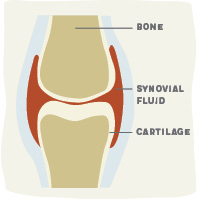Joint Health for Dogs and Cats
Is your fur kid slowing down?
Every dog and cat is a masterpiece of movement, thanks to the exquisite workings of the muscles and joints in their bodies. But as they age, joints can wear down, causing pain and swelling and discouraging movement in general. Mobility problems will affect many dogs and cats at some time in their lives and are the most common source of chronic pain.
Most joint pain is due to arthritis. Osteoarthritis, often called arthritis, is a common ailment, especially for older pets and certain breeds. Unfortunately, it is also a progressive disease. Although there isn’t a cure, minimizing pain and inflammation is possible with an improved diet and all-natural, drug-free joint supplements.
Anatomy of a joint
 Inside a joint capsule, cartilage wraps around the ends of the bones to prevent them from rubbing together, and thick synovial fluid ensures a gliding, frictionless movement. Ligaments hold the bones in proper alignment with each other.
Inside a joint capsule, cartilage wraps around the ends of the bones to prevent them from rubbing together, and thick synovial fluid ensures a gliding, frictionless movement. Ligaments hold the bones in proper alignment with each other.
A healthy joint is self-repairing; when the cartilage is damaged, specialized cells inside the joint capsule can grow new cartilage cells and remove the damaged ones. Other special cells will replenish synovial fluid to keep the joint well-hydrated. When the loss of cartilage accelerates, and the body can’t keep up, painful arthritis sets in. This can happen quickly from injury or develop slowly and may be almost undetectable due to aging.
Know what to look for
Typical signs of joint problems include a stiff gait, difficulty getting up, reluctance to jump or climb steps, slowing down on walks, and greater inactivity in general. Because these signs are easy to overlook, they can go unnoticed for a long time. Cats, especially, tend to hide their pain. An indication that a cat is experiencing pain is if they no longer jump up on high places, perform acrobatic leaps when you wave the wand toy, or even stop grooming themselves.
Cleaner diet, improved joints
At the molecular level, cartilage and ligaments are a matrix of collagen fibers interspersed by long chains of glycosaminoglycans (GAGs), that attract and hold water. Glucosamine, chondroitin, and hyaluronic acid (the main component of synovial fluid) are all GAGs, which are produced by the cells of the body and can also be ingested in many meat-based foods. To introduce joint-building menu items, try some cartilage-rich chicken or turkey necks or backs – raw or freeze-dried are good ways to get the most nutrients. Bone broth, a nutritious stock made from these same collagen-dense parts, is another easy way to incorporate healthy joint building blocks into your dog or cat’s diet.
Serving your pet more meat and fewer carbs can also help control or reduce body weight, an important factor in decreasing joint stress. Fresh, less processed food usually contains fewer inflammatory ingredients, reducing immune system stress so your pet can focus more energy on healing and repairing joint tissue as needed.
Joint Supplements
At the first sign of any symptoms—or even preemptively if you have a breed that’s prone to joint issues—we recommend that you reach for a good joint supplement. There are many all-natural, drug-free products that can promote the growth of healthy joint tissue and ease pain in a remarkably short time. Our favorite is Connectin Hip & Joint, a clinically tested remedy containing glucosamine, chondroitin, hyaluronic acid, and nine therapeutic herbs. It can bring results in only 15 days and comes in many forms – a flavored powder, a chewable tablet, and a soft chew.
Other excellent products are Liquid Health, in an easy-to-use liquid form, and Super Snouts Joint Power with pure New Zealand green mussel powder.
Omega-3s from Fish Oil
Painful joints are an inflammatory condition, and omega-3 fatty acids are well-known for reducing inflammation that causes pain and swelling. Fish oil is the best source of omega-3s for both dogs and cats, as it provides both eicosapentaenoic acid (EPA) and docosahexaenoic acid (DHA), which are the long-chain forms of omega-3 that their bodies use. Dogs and especially cats cannot easily convert the short-chain omega-3 alpha-linoleic acid (ALA), mainly sourced from plants like flax and chia, into usable EPA and DHA. Add fish oil to food daily just before serving. Pets generally like the flavor, and rotating among different sources like salmon, sardine, pollock, or a fish oil blend will provide a wider spectrum of essential fatty acids. As a side benefit, omega-3s also help cognitive function, can minimize allergies, and improve outcomes in some cancer treatments.
Some of our favorites are Wisely Salmon Oil, Wisely 50/50 oil, or Wisely Pollock Oil, made from sustainable wild-caught Alaskan fish, and pharmaceutical-grade Nordic Naturals Omega-3 Pet, which has absolutely no fishy smell.
Address joint pain with Cannabidiol (CBD)
While research into CBD benefits in animals is in the preliminary stages, initial findings show that CBD products can provide arthritis relief by reducing inflammation and pain in dogs with joint issues, resulting in increased mobility. A study from Cornell University found that CBD twice daily can help increase comfort and activity in dogs with osteoarthritis. This study found no side effects of CBD treatment and no indications of any psychoactive effects from the full-spectrum CBD oil, which contains less than 0.3% THC.
Despite limited quantitative data, many dog owners report seeing fast, visible improvements in their dogs’ mobility and reduced pain symptoms when regularly given CBD. CBD that’s specially formulated for pets is available in many convenient options, including treats, tinctures, and capsules. Wisely CBD has helped many animals move with less pain. Read more about it here.
For optimal results, when it comes to putting the pep back in your pet’s step, we recommend utilizing all approaches: a top-quality diet, joint supplements, fish oil, and CBD.

